Ljubljana related
STA, 8 December 2020 - The world's top ski jumpers will converge on Slovenia's Planica this week for the Ski Flying World Championships, which has been moved up from March due to the Covid-19 epidemic. The event will be held for the first time without spectators, under floodlights, and under strict anti-epidemic rules.
Last season ended prematurely for ski jumpers and the Ski Flying World Championships was postponed to December. After almost nine months, Slovenia is thus finally hosting the main ski flying event in the world.
Slovenian jumpers will be defending their team silver medal from Germany's Oberstdorf in 2018, although without spectators, who traditionally pack the stadium below the large hill of the Planica Nordic Centre and create a roaring atmosphere.
Planica under floodlights for the first time, without spectators and under strict ant-epidemic measures
This time, the valley under the Ponce mountains in the north-western corner of Slovenia will be fully closed for spectators, and access to the valley by car will be prohibited. Fans of ski flying will have to watch the ski flyers at home.
This is not the only unusual thing, as it will also be the first time in the history of the Gorišek Brothers' ski flying hill that a competition will be held under artificial lights. The organisers needed a lot of them, equalling to lighting of two football stadiums in Ljubljana, head of competition Jelko Gros has told the STA.
Immediately after the competition was cancelled in March due to the coronavirus outbreak, the organisers saved around 9,000 cubic metres of snow from the area, which has been preserved to be used for the competition in December.
The organisation is much more difficult than usual, as precautionary measures need to be taken for possible positive Covid-19 tests. For this reason, the event will be organised with the smallest possible number of staff.
Gros will be heading a competition at Planica for the last time, and his current assistant Aljoša Dolhar will take over from him for the World Cup season finale next March.
"Due to coronavirus, we have managed the event in a way that enables it to continue even if some of were to test positive or had to be quarantined due to contact with an infected person," Gros described the problems related to Covid-19.
All participants will need to be tested, and the area will be divided into two zones. As many as 80 staff will organise the competition in the green (safe) zone or the snowflake, as the quarantine bubble is called in the winter sport circles.
The remaining staff will be in the grey zone, where they will be tested with rapid tests performed by the Jesenice general hospital. Persons from the two zones are not expected to be in contact, except in special circumstances.
Slovenian "eagles" have eight medals from world championships, but none from Planica
Slovenian ski jumpers have so far won eight medals at the Ski Flying World Championships, but none of them comes from Planica, which will this year host the event for the seventh time after 1972, 1979, 1985, 1994, 2004 and 2010.
The first medal (silver) was won by Primož Ulaga in Oberstdorf in 1988, who was followed by Urban Franc in Kulm in 1996 (bronze), and Robert Kranjec in Vikersund in 2012 (gold). It was there that Kranjec and his compatriots Jernej Damjan, Jurij Tepeš and Jure Šinkovec won the team bronze.
Two years later in Harrachov, Peter Prevc won bronze, and the most successful Slovenian ski jumper ever also won the world champion title in Kulm in 2016. At the latest championship in Oberstdorf, Slovenians continued the medal streak by returning home with the team silver in the line-up Peter and Domen Prevc, Anže Semenič and Jernej Damjan.
Slovenians ski flyers are determined to finish on the podium in Planica, with head coach Gorazd Bertoncelj having already selected the competitors from the ranks of the home nation - Anže Lanišek, Bor Pavlovčič, Žiga Jelar, Peter Prevc, Timi Zajc and Domen Prevc.
Slovenians are not really in an excellent shape, but large ski flying hills have always served as a "wake up" for them, which is something they are counting on this year.
Many unknowns about competition as coronavirus affects ski jumping
Ski jumpers have not been spared the coronavirus pandemic in the new season, and Ski Jumping World Cup director Sandro Pertile will miss the event as he has tested positive. It is not known yet what the competition will actually be like.
Having the most problems is the Austrian team, where the nine positive jumpers include Stefan Kraft, the world record holder (253.5 metres in Vikersund in 2017) and the World Cup winner from last season.
Four of them have since returned negative tests, including Kraft. The decision on who will represent Austria is expected to be taken by Wednesday.
On the other hand, the Norwegian team is coming to Slovenia in an excellent shape, after winning the team gold and the individual gold medal (Daniel-André Tande) at the last world championship in 2018. This time, the role of favourite will be played by Halvor Egner Granerud, who has won the last three World Cup events.
Having entered the season on a roll are the Germans with Markus Eisenbichler, the winner of the last event held at the Gorišek Brothers hill. Poland's Kamil Stoch, Dawid Kubacki and Piotr Žyla, who missed the last World Cup event in Russia and are training for the world championship at home, are also known for their aptitude for long flights.
The European Space Agency (ESA) has announced a new series of bedrest studies, some of which will take place in Slovenia, with the aim being to learn more about the human body in space. In a bedrest study volunteers stay in bed for long periods of time – 60 days in the research set to be carried out in Planica by the Jožef Stefan Institute.
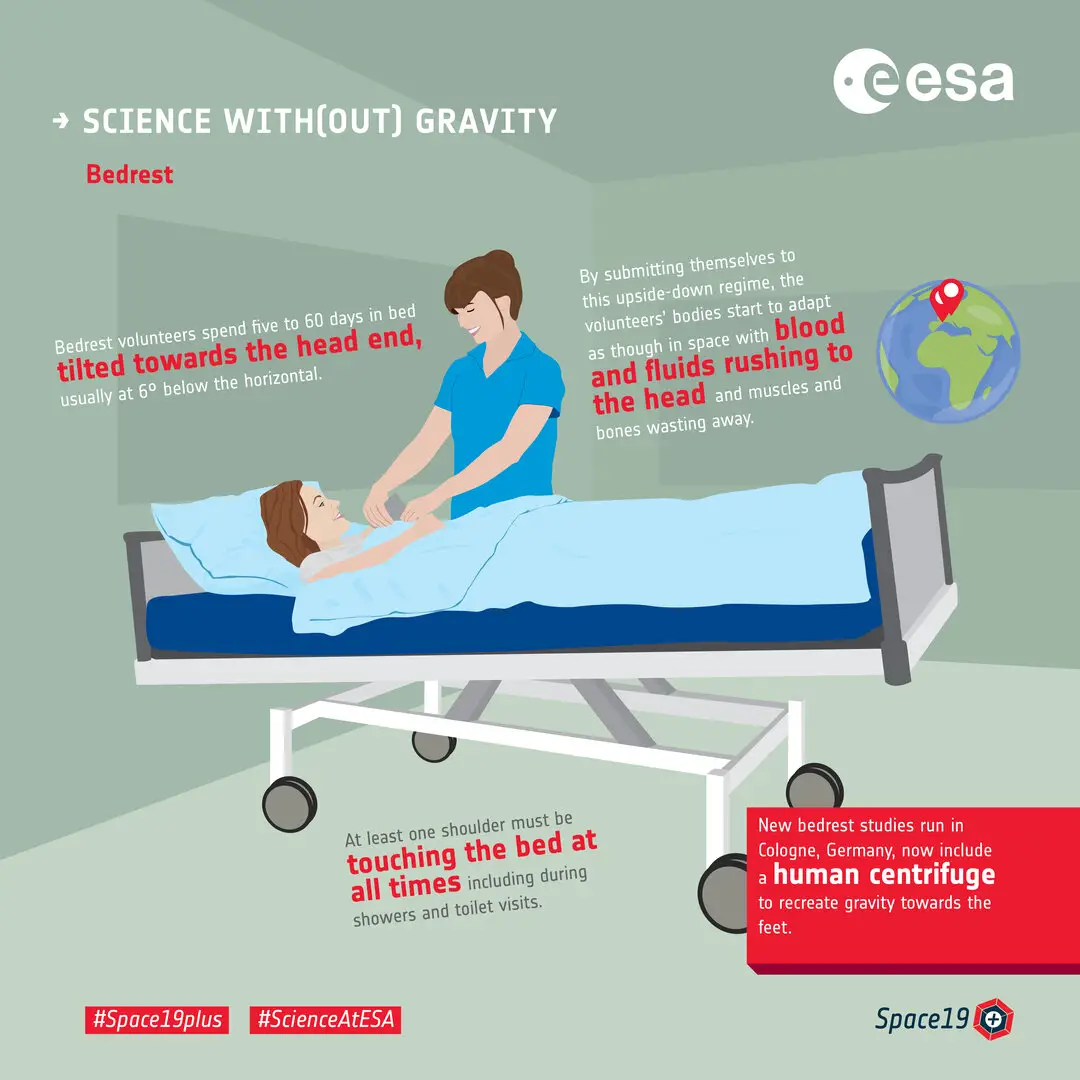
Source: ESA
But a lack of movement won’t be the only limitation on participants for two months, as there are two further conditions attached to successful participation. First, while in bed their heads must remain 6° below the horizontal. Second, throughout the whole 60 days at least one shoulder needs to remain in contact with the bed at all times – during meals, showers and toilet breaks. The effects of this regimen will be blood and other fluids moving towards the head, as muscles and bones start wasting away.
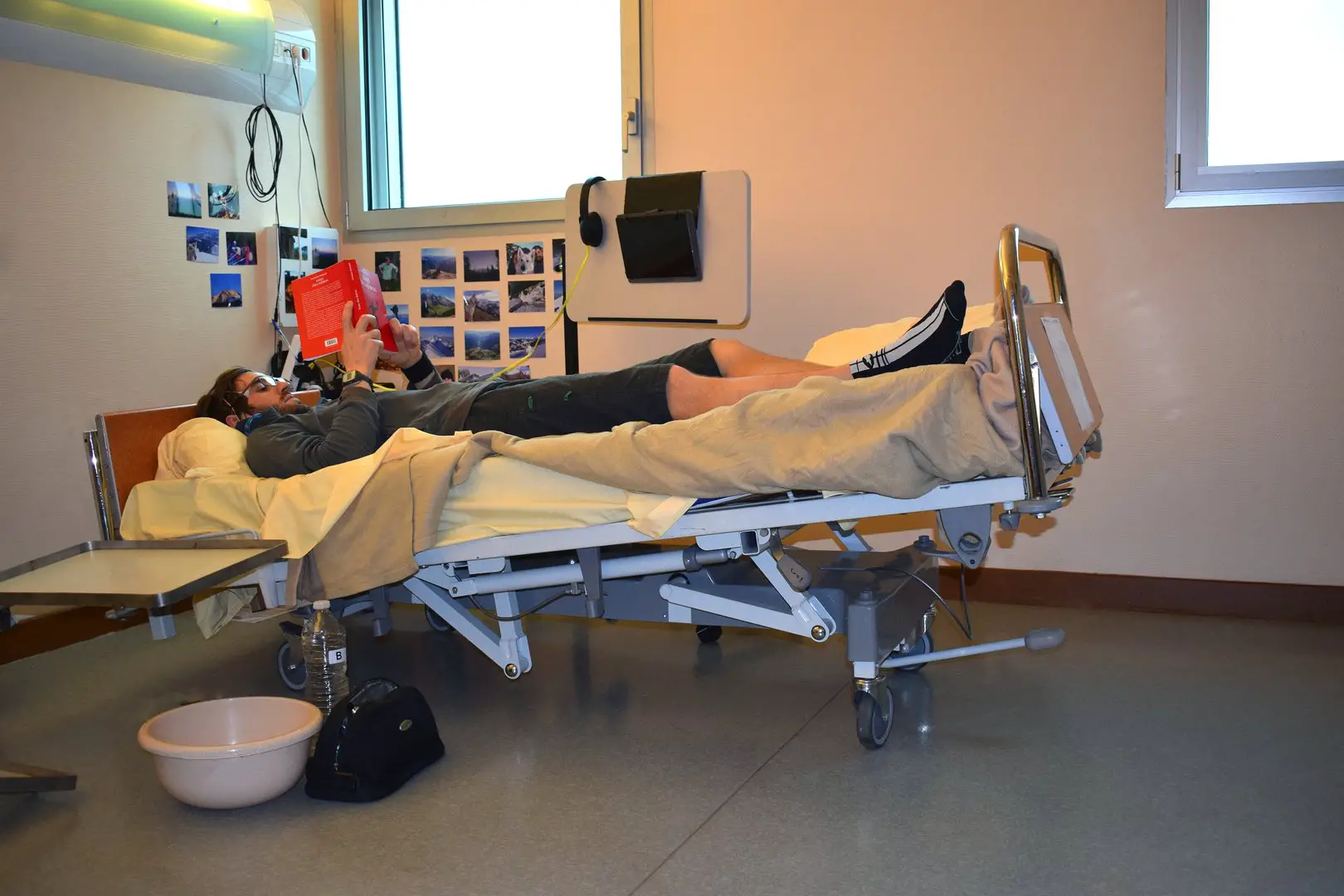
Source: ESA
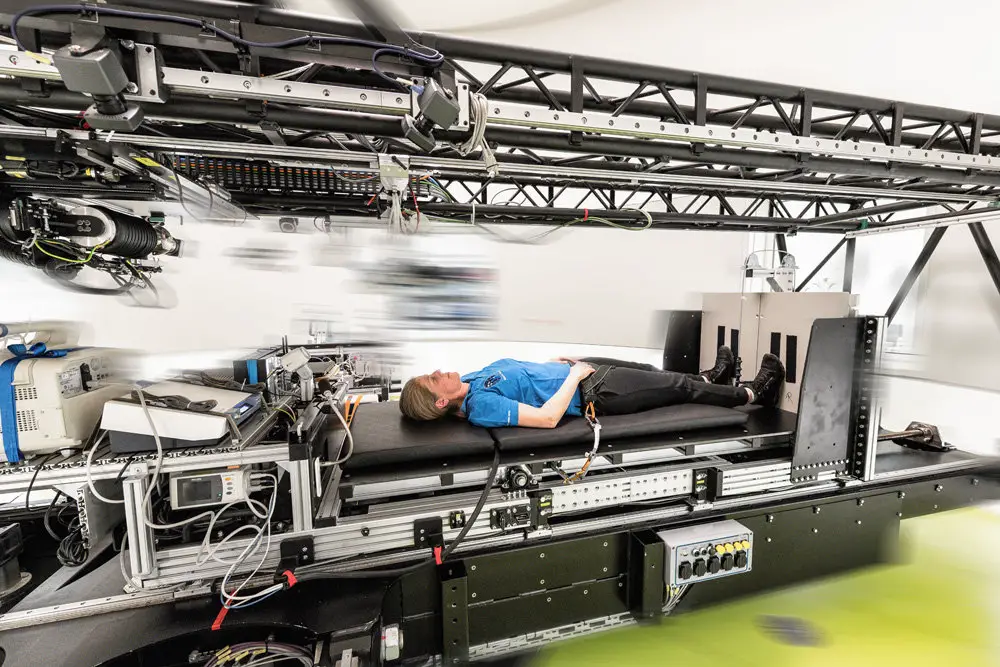
Source: ESA
And while they’ll be staying on their backs the 48 volunteers will see some movement, as the centre is equipped with a centrifuge that can spin them around to recreate gravity pulling towards their feet while laying down, so research can find out ways to counteract the adverse effects of living in space.
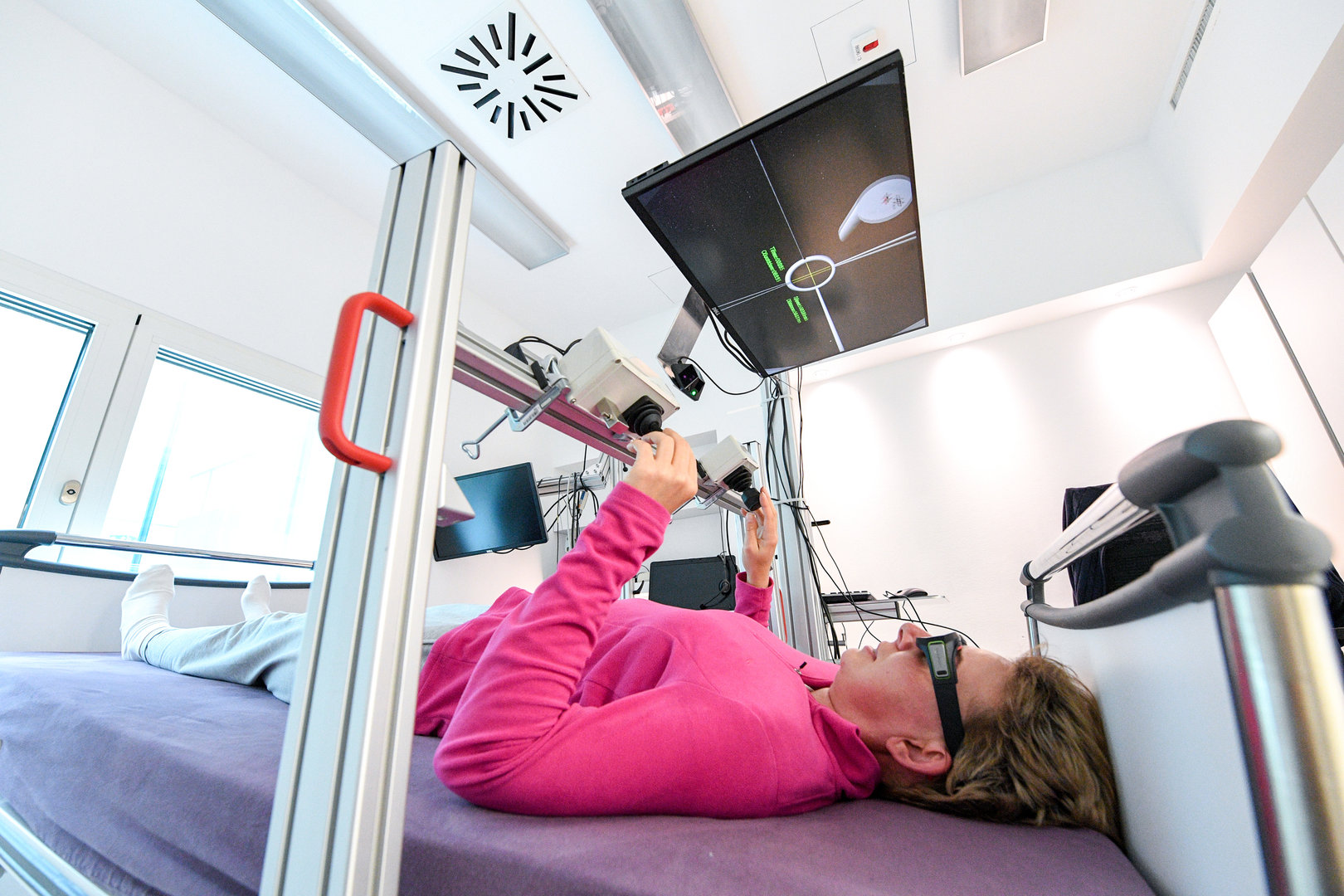
Source: ESA
A press release by the ESA notes that Planica is a good location for studying the effects of life off the planet , since it is located at high altitude and there is less atmospheric pressure, as in any future lunar habitat. To further add to the realism the test centre also enables researchers to change the environmental conditions to make them better resemble those in a spacecraft or space habitat. Testing volunteers with low oxygen levels, for example, can produce data relevant to future space missions where the confined environments of spacecraft and space habitats could contain less oxygen.
A total of 48 volunteers are wanted, half of whom will be in Slovenia, the other half in France, and they’ll be paid around €15,000 for their help. The call for volunteers to take part in the study doesn’t seem to be open yet, but you can learn more about the project, which is accepting research proposals for other things to subject the participants to, here.
STA, 12 November 2019 - The designers of the Planica Nordic Centre in north-eastern Slovenia has received a gold medal for an architectural achievement by the International Olympic Committee (IOC) and the International Association for Sports and Leisure Facilities (IAKS) among almost 100 competing projects.
The awards were announced at the 26th international IAKS congress in Cologne, Germany, last week, and presented officially on Tuesday by the Slovenian Ministry of Education, Science and Sport.
The Nordic skiing complex with one ski flying hill, seven ski jumping hills and a cross-country skiing track is one of the seven recipients of the gold medals among a total of 98 competing projects.
What speaks of the success of the Planica Nordic Centre is that the award for an architectural achievement in the past went to the likes of Beijing National Stadium, also called The Bird's Nest, and National Stadium in Singapore.
For instance, the latter cost EUR 1.2 billion build, while the cost of the Planica Nordic Centre was around EUR 48 million.
The project by three architectural firms (Stvar, Abiro and Akka) has been recognised by an international jury as a "modern complex created by expanding and modernising the existing facilities in the Triglav National Park."
According to the jury, it is noted for versatile and year-round use for elite sport and major international events, as well as tourism and recreation, and is marked by its clear, linear design in harmony with the landscape.
The jury has also been impressed by the "magnificent integration of the facility into the landscape" and the use of an underground tunnel for cross-country skiing in the summer.
Matej Blenkuš of Abiro said at today's event that while there were financial constraints, the architects were happy to "build in one of the most beautiful environments in Slovenia."
Such an environment puts overly ambitious architects on realistic grounds, as it sends a message that no one should date to change such an environment," he added.
Aleš Vodopivec of Stvar said that the project was an "unbelievable challenge, but the award proves that we have been successful".
Apart from hosting the Ski Jumping World Cup finale every year, the Planica Nordic Centre will host the Nordic World Ski Championships in 2023, at which tens of thousands of fans are expected to show up.
All our stories on Planica are here
Planica is mainly known as the location for the climax of the world ski flying season, when lightweight, daring athletes hurtle down the Gorišek Brothers Flying Hill and then speed through the air for up to a quarter of kilometre before touching down. The current record, set here in 2019 by Ryoyu Kobayashi, is 252 metres – equivalent to the frankly unbelievable length of 2.27 football (soccer) pitches.
But it’s also the site of another event, one that’s to open all to participate in and sees competitors run or stagger up the fearsome slope. This is when Planica is known as the most demanding part of the whole Red Bull 400 circuit, one that takes in 17 locations around the world. The athletes will cover just 400 metres in their ascent, but with a height gain of 202 metres – a real challenge for the legs, heart and lungs, as seen below.
The event takes place on Saturday, 14 September (2019), with the races starting at 11:45 and continuing until the very precisely scheduled Men’s Final 16:18. The challenge is open to anyone aged 16 and over on the day of the event, with full 400m races being run separately for men and women, as well 4x100m relays for men, mixed and “professional” groups. The official site is here.
It’s now too late to register, but if this kind of thing is your idea of fun then keep an eye to the as yet to be announced date of next year’s Red Bull Goni Pony challenge, riding one of Rog’s iconic little cycles up the road to the Vršič Pass. In terms of the brute facts this means pedalling 13.5 kilometres to the top of a mountain, a route that includes 24 hairpins turns and rises 801 vertical metres, with an average incline of 10.8%. This year it was in June, so you have plenty of time to get training.
STA, 24 March 2019 - Overall World Cup winner Ryoyu Kobayashi of Japan won the final event of the World Cup season in Planica on Sunday after equalising the hill record in the first series. Domen Prevc of Slovenia finished second ahead of Friday's winner, the German Markus Eisenbichler.
Kobayashi managed to equalise the giant hill record of 252 metres in the first series, just a metre and a half below the world record, and cemented his 13th season win with 230.5 metres to beat Prevc, who flew 239.5 and 222.4 metres, by almost 25 points.
Eisenbichler in third was just a point and a half shy of Prevc with jumps of 227 and 235 metres.
"I feel wonderful, the emotions are out in full force," Prevc said about his performance in front of the home crowd. "I knew I'd be on the podium, but I did not know I'd take the lead," he said.
Slovenia had two more top-ten finishes, as Timi Zajc grabbed fifth place and Anže Semenič was ninth with a personal best of 241 metres.
All our stories on Planica, past and present, are here
* Results: 1. Ryoyu Kobayashi (Jap) 464,9 points (252,0/230,5 metres) 2. Domen Prevc (Slo) 444,0 (239,5/222,5) 3. Markus Eisenbichler (Ger) 442,5 (227,0/235,0) 4. Piotr Žyla (Pol) 438,6 (248,0/222,0) 5. Timi Zajc (Slo) 425,4 (231,5/229,5) 6. Dawid Kubacki (Pol) 424,8 (229,5/234,0) 7. Karl Geiger (Nem) 422,8 (238,5/228,0) 8. Johann Andre Forfang (Nor) 416,2 (225,0/223,5) 9. Anže Semenič (Slo) 413,8 (241,0/224,0) 10. Jevgenij Klimov (Rus) 411,7 (233,0/221,5) ... 19. Peter Prevc (Slo) 381,0 (221,5/204,5) 29. Anže Lanišek (SLO) 317,8 (195,5/201,5) ... - Final World Cup standings: 1. Ryoyu Kobayashi (Jap) 2085 2. Stefan Kraft (Aut) 1349 3. Kamil Stoch (Pol) 1288 4. Piotr Žyla (Pol) 1131 5. Dawid Kubacki (Pol) 988 6. Robert Johansson (Nor) 974 7. Markus Eisenbichler (Nem) 937 8. Johann Andre Forfang (Nor) 892 9. Timi Zajc (Slo) 833 10. Karl Geiger (Nem) 765 ... 13. Domen Prevc (Slo) 542 28. Anže Semenič (Slo) 203 29. Peter Prevc (Slo) 179 30. Anže Lanišek (Slo) 177
STA, 23 March 2019 - Robert Kranjec, one of the best Slovenian ski jumpers of all time, bid an emotional farewell to his fans after a career spanning 21 years with one final flight down the Planica ski-flying hill on Saturday.
Appearing in 325 Ski Jumping World Cup events, Kranjec tallied 15 victories and a total of 27 podium finishes, team events included, since his debut in Trondheim in 1998.
He was part of the team that won bronze at the Salt Lake City Olympic Games in 2002 and ten years later became the world champion in ski flying, his flagship discipline, with a jump of 244 metres.
Indeed, it was his exceptionally good feeling for flying which earned him the moniker the Flying Carniolan (Leteči Kranjec), something that he demonstrated once again today.
Having become the first jumper to cross the 200-metre mark 200 times at Planica last year, Kranjec improved this special record today, landing at 213.5 metres, in his 212nd over the 200-metre flight.
In his final feat he was cheered on by a crowd of 21,200 gathered in the Alpine valley offered referred to as the "cradle" of the sport.
Among those who came to pay him tribute was Primož Roglič, his former team mate who went on to become Slovenia's cycling sensation. He presented Kranjec with a yellow jersey.
Kranjec, reaching the outrun of the ski-flying hill after the first series of today's team event, which saw Slovenia finish third, sent items of his gear flying among the fans as keepsakes before being overwhelmed by a wave of hugs and cheers.
"Thanks to the fans! Thank you for cheering me on for every flight and thank you for supporting the team," the 37-year-old said in an emotional goodbye.
His first individual World Cup victory in Kuusamo in 2005 was his sole individual win in ski jumping, the remaining six being achieved on the ski-flying hills of Planica, Vikersund and Kulm.
Apart from winning the 2012 ski-flying championship, he won two more team world championship medals, the team ski-jumping bronze in Oslo in 2011 and bronze in the ski-flying team event in Vikersund a year later.
This was his last medal in such a major competition. What followed was a difficult period in which he struggled with injury.
First he had difficulties with his elbow, but he still finished top of the podium two times in the 2015/16 season. When he appeared to be coming back to the top, he suffered a bad knee injury just before the next season, followed by surgery and a lengthy recovery.
After struggling through last year's season, he considering retiring, but decided to give it one more try. It was his back that gave him problems this time, so he decided to call it quits.
"I've decided this will be my last journey to Planica, because I will end by career in Planica," Kranjec said ahead of today's event saying that he made the decision in January.
Poland won the team ski flying event at the World Cup meet in Planica, ahead of Germany and Slovenia, to the thrill of thousands of fans who gathered at the foot of the giant hill in lovely weather on Saturday.
With fine long jumps Jakub Wolny, Kamil Stoch, Dawid Kubacki and Piotr Žyla secured an unassailable lead already in the first series.
They scored a total of 1627.9 points, 8.1 points more than Germany and 24.8 points more than Slovenia's Anže Semenič, Peter Prevc, Domen Prevc and Timi Zajc in third.
All our stories on Planica, past and present, are here
There was a bit of tension in the final series when Žyla touched the ground with his hands on landing, but Poland's score lead was just too strong to make any surprises possible.
This was the third World Cup team victory for Poland this season after those in Wisla on 17 November and Willingen on 15 February.
The battle for the second spot was much more tight with Slovenia finishing second after the first series. However, after an excellent jump by Karl Geiger, who landed at 230 metres, Germany edged ahead.
In the first series, Semenič landed at 228.5 metres, followed by Peter Prevc, who made it to 212 metres, his brother Domen flew 229.5 metres far and Zajc landed at 224.5 metres.
In the final series Semenič only made it as far as the 218-metre mark, Peter Prevc upped it to 223 m and then Domen Prevc landed as far as 239 m, followed by Zajc's flight of 235.5 metres.
"Peter Prevc was still a bit unsteady in the first series, but the second jump was good again. Anže Semenič was excellent in the first series, but made a bit of a blunder in the second. The youngest two were flawless," Slovenia head coach Gorazd Bertoncelj commented.
After the end of the first series, Robert Kranjc, one of the best Slovenian jumpers of all time, officially ended his career with one last jump, cheered on by the 21,200-strong crowd.
The three-day Ski Jumping World Cup finale in Planica will close on Sunday with an individual event for the top 30 ranking in the overall World Cup standings.
* Results, team event: 1 Poland 1627.9 points (Jakub Wolny 237.5/228.5 m, Kamil Stoch 227/221, Dawid Kubacki 229.5/230, Piotr Žyla 226.5/242.5) 2 Germany 1619.8 (Karl Geiger 230.5/230, Constantin Schmid 217/216.5, Richard Freitag 221/231, Markus Eisenbichler 227/246) 3 Slovenia 1603.1 (Anže Semenič 228.5/218, Peter Prevc 212/223, Domen Prevc 229.5/239, Timi Zajc 224.5/235.5) 4 Japan 1520.8 (Yukiya Sato 211/221, Noriaki Kasai 213/210, Junshiro Kobayashi 218/225, Ryoyu Kobayashi 240/237) 5 Austria 1520.8 (Michael Hayböck 218/225, Philipp Aschenwald 215.5/213, Daniel Huber 222.5/226, Stefan Kraft 208/221) 6 Norway 1502,6 7 Switzerland 1312,1 8 Finland 1177,6 ... - without a final: 9 Czech Republic 570.2 10 Russia 430.8
March 22, 2019
Breaking records is an important part of ski flying competitions, and breaking the world record has presented a particular challenge not only to the athletes, but to the hill engineers and event organisers as well.
There are five large ski flying hills that have played a major role in the sports’ development since the 1950s.
The five ski flying hills
Kulm hill in Austria, built in 1950, further upgraded in 1953, 1986 and 2015, was a site of world record flights in 1962 (141 metres), 1965 (145 metres; both jumped by Peter Lesser) and 1986 (191 metres by Andreas Felder). The current record of the hill stands at 244 metres by Peter Prevc, set in 2016.
Heini Klopfer hill in Oberstdorf, Germany, named after the hill’s architect, Heini Klopfer, was also built in 1950 and then upgraded in 1972, 1997 and 2017. After its first upgrade the hill was the chief rival to the Gorišek Brothers’ hill in Planica, and the hill record race that ensued between the two in the 1970s also sparked the first serious safety concerns and calls for tighter regulation and control by the International Ski Federation. Heini Klopfer hill in Oberstdorf was a site of a series of world record flights from 1950s to 1967 and then from 1973 into the mid-1980s. No new world records were broken in Oberstdorf after Planica took over as the site of world record jumps in 1987 and Vikersund took over from Planica in 2011. The current hill record in Oberstdorf was set at 238.5 metres by Daniel-André Tande in 2018.
Gorišek Brothers hill in Planica, Slovenia, named after the hill architects Janez (1933 -) and Lado (1925 – 1997) Gorišek. Today Janez is considered as the World’s no. 1 expert in ski flying engineering and the main man behind the renovation of the currently world record dominating hill in Vikersund. The flying hill in Planica was inaugurated in 1969 with a series of world record flights. It was upgraded in 1979, 1985, 1994, 2000, 2003, 2005, 2010 and 2013/15. Starting with Piotr Fias’ 194-metre world record in 1987, Planica completely dominated as the location for world record jumps site for 24 years until the most recent renovation of the Vikersund hill in 2011. The last world record on this hill was set by Bjørn Einar Romøren, at 239 metres, in 2005, and the current hill record was marked at 252 metres by Ryoyu Kobayashi in 2019.
Vikersundbakken or Vikersund hill in Norway, the current world record holder, was already built in 1936 but has only been categorised as a ski flying hill since its 1966 upgrade. Like the rest of the ski flying hills, Vikersund has undergone several renovations since, notably the most recent one, that involved a complete rebuild of the in-run and was overseen by Planica’s main architect, Janez Gorišek. This renovation meant the end of Planica leadership in world record jumps and installed Vikersund as the place where the last six records were set, with what today remains the longest jump ever made on skis, at 253.5 metres by Stefan Kraft in 2017.
Četrt’ák hill in Harachov, Czech Republic, joined the race in 1980 and earned an early reputation of being dangerous to jump from, mostly due to strong cross winds that are present at the site. Two world records were obtained there, one in 1980 (Armin Kogler, 176 metres) and the second one in 1983 (Pavel Ploc, 181 metres). The hill underwent some renovations in the years between 1989 to 1992, nevertheless another rather famous fall occurred in 1992, with Andreas Goldberg crashing onto the slope from the highest flying point of his jump. With changes in equipment and flying technique, however, ski flying presents less danger to jumpers even in Harrachow, where the current hill record was set at 214.5 metres by Matti Hautämaki in 2002 and repeated again by Thomas Morgenstern in 2008. In 2011 Jurij Tepeš crash-landed at 220 metres, although if you are not standing on your feet at landing then this does not count as a successful jump, and therefore cannot count as a world record either.
Record Breaking vs. Safe Landing
Although ski flying safety has improved significantly in the last few decades, the question of “how far is still safe?” remains, which is quite evident from the video above, due to the levelling off of the slope towards the bottom of the hill.
The big debate about safety emerged in the 1970s amid the rivalry between Planica and Oberstdorf. In 1974 the debate also reached its peak artistically with a Werner Herzog documentary about Walter Steiner’s safety concerns at the 1974 flights in Planica.
The film depicts Walter Steiner at the top of his career in a season in which he was beating his entire competition in double digits by length of his jumps. The world record holder at the time was Heinz Wossipiwo, with 169 metres jumped in Oberstdorf in 1973, when Steiner crash-landed twice, at 175 and 179 metres. Steiner’s concerns in the movie mostly revolve around the organisers’ lack of safety considerations in Planica that year, as they appeared to be more concerned with the possibility of a record than basic safety of the jumpers. “I feel I’m in the arena with 50,000 people waiting to see me crash”, Herzog reports him saying in the film.
At about 20:52 in the film above, just after Steiner’s crash landing at 177 metres, a jumper with a starting number 1 appears in the background, warming up for his second jump. The jumper’s name is Janez Loštrek, father of the author of this article, so we seized the opportunity and asked him to comment on his colleague’s struggles from that year.
He told us that although the push for a record existed at all hills at the time, the problem Steiner was facing in 1974 in Planica was a new one. Whether or not his struggles in Planica could be related to his two record crash-landings in Oberstdorf in the previous season, Loštrek doesn’t know because his first ski flying season was only in 1974 in Planica.
Regulations and the composition of the match organising committees also gradually changed in favour of better safety controls, along with advances in technology with regard to monitoring and scoring of the jumps. The issue of adjusting the in-run length to the capabilities of an individual jumper is not a problem anymore, as it can be shortened today on request by a coach with an appropriate score adjustment of such a jump, but in the 1970s this wasn’t yet possible.
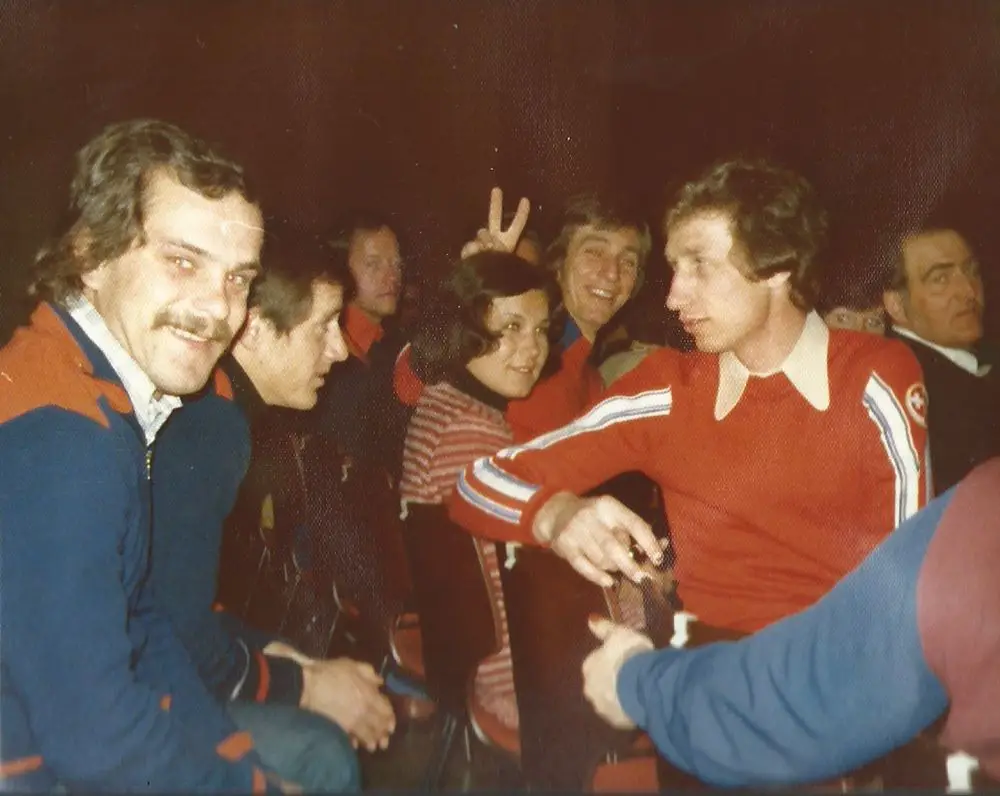
In the 1974/5 season, the International Ski Federation (FIS) tried to address the issue of jumpers in top form by introducing a separation of the first 15 from the practice day, sending them to a lower in-run point on the day of the competition without the possibility of the rest of the competitors who were jumping from a higher point to take any of the first 15 places, in effect creating two separate competitions. The system didn’t last long, as practice jumps don’t necessarily tell much about someone’s ability on the actual competition day. Note that the only practice time for jumpers at the flying hills is usually on the first day of the ski flying event, because the flying hills are only prepared for jumping for the time of competition.
Safety in ski flying was further improved with the introduction of the FIS Ski Jumping World Cup in the 1979/80 season, bringing in more external regulation and control, further limiting the possibility of the events depicted in the movie above. Also, the equipment changed, with helmets and high boots, while the skis became lighter and a mechanism was developed that kept them from flipping over in bad weather. The whole system was improved, but with new solutions come new problems. Since the introduction of V-style jumping in the 1990s, the weight of a jumper plays an important role, something that has already been addressed by regulations on ski length to avoid harsh dieting by more heavily built jumpers. This rule is currently under debate to be even tighter, as weight control seems to still be too great of a factor for some of the jumpers, who could instead be focusing on the athletic aspect of the sport.
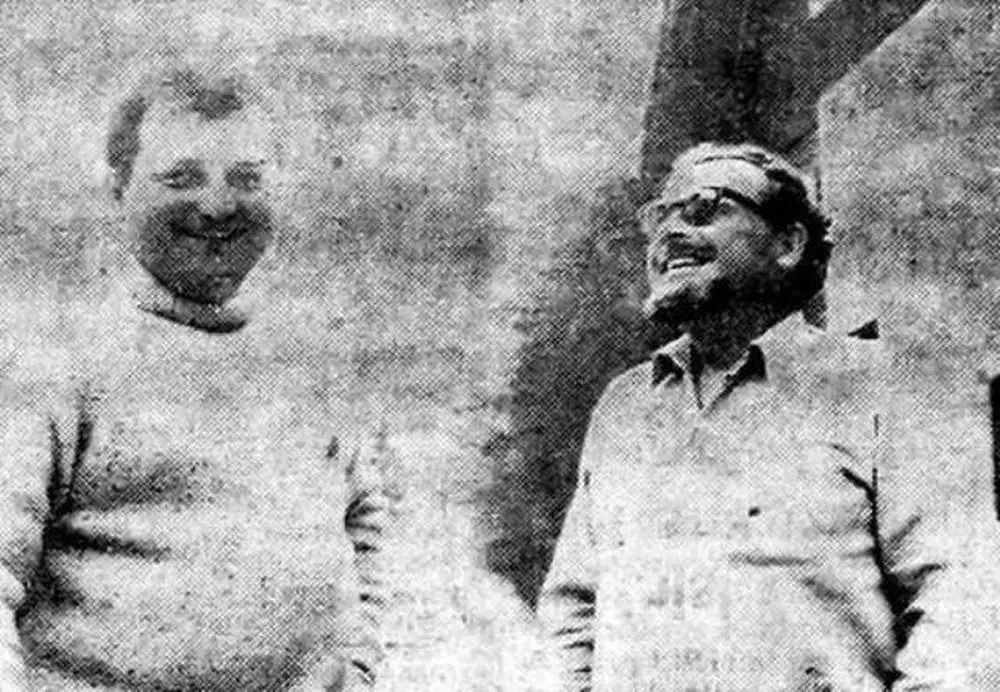
Meanwhile, Janez Gorišek (1933 -) and his youngest son Sebastjan, Janez’s main partner in latest designs of the world’s two largest hills, Planica and Vikersund, are already looking ahead, for solutions for a 300-metre flight. “The development of ski jumping never stops, so the engineers cannot stop either. This is also my view on the current duel between the hills in Vikersund and Planica. The profiles of the both were designed by Sebastjan and I. We also advised the Austrians in Kulm. However, the Norwegians are most in favour of our views. Apparently we also need each other most. We are both inclined to new goals and together we are the strongest,” said Janez Gorišek in a recent interview for Delo.
STA, 22 March 2019 - Markus Eisenbichler of Germany won the first individual event of the Ski Jumping World Cup season finale at Slovenia's Planica on Friday, beating Japan's Ryoyu Kobayashi, who has already secured overall win in the competition.
The reigning world champion on the large hill collected 445 points from the two jumps to earn his first win in the World Cup, beating the Japanese sensation by almost seven points.
The third place went to Piotr Žyla of Poland (437.3 points), who was followed by Timi Zajc, the best Slovenian in the World Cup this season, who set a personal best of 240m in the first round.
Eisenbichler now leads the ski flying standings one event to go with 311 points ahead of Kobayashi (307) and Žyla (239).
Zajc told reporters he was very happy despite missing on a podium finish, adding that Slovenia was among the favourites for Saturday's team event. "It makes sense to count on a podium finish tomorrow."
Related: All our stories on Planica, past and present, are here
"We showed last week that we can win the first place," he said referring to the team's win in Norway last week, adding that "we can do it if all four of us manage good jumps."
The announcement is realistic as Slovenia had two other representatives in the top 10 - Domen Prevc in fifth place and his older brother Peter in tenth.
The season finale events hosted by Planica will conclude with another individual event for Sunday.
* Results of Friday's Ski Jumping World Cup event at Planica:
2 Ryoyu Kobayashi (JAP) 438.1 (242.0/220.0) 3 Piotr Žyla (POL) 437.3 (242.0/234.0) 4 Timi Zajc (SLO) 422.5 (240.0/228.5) 5 Domen Prevc (SLO) 415.2 (233.5/224.0) 6 Simon Ammann (SUI) 411.6 (234.5/238.0) 7 Dawid Kubacki (POL) 405.5 (222.0/230.0) 8 Johann Andre Forfang (NOR) 405.4 (230.0/221.5) 9 Karl Geiger (GER) 404.7 (227.0/226.0) 10 Peter Prevc (SLO) 401.5 (225.5/226.5) ... 20 Anže Semenič (SLO) 371.6 (219.0/217.5) 29 Bor Pavlovčič (SLO) 354.1 (201.5/211.0) - Overall standings (28 of 29 events): 1 Ryoyu Kobayashi (JAP) 1,985 2 Stefan Kraft (AUT) 1,335 3 Kamil Stoch (POL) 1,264 4 Piotr Žyla (POL) 1,081 5 Robert Johansson (NOR) 959 6 Dawid Kubacki (POL) 948 7 Markus Eisenbichler (GER) 877 8 Johann Andre Forfang (NOR) 860 9 Timi Zajc (SLO) 788 10 Karl Geiger (GER) 729
STA, 22 March 2019 - The Planica ski flying hill will traditionally host the Ski Jumping World Cup season finale between Friday and Sunday, with the organisers promising a spectacle involving the world elite despite the fact that the overall winner has already been decided.
While Ryoyu Kobayashi of Japan has secured the overall individual win in the 40th World Cup season long ago, the fight for the small crystal globe for ski flying is still open.
Kobayashi in also in the lead in this department, being closely followed by Markus Eisenbichler of Austria and Kamil Stoch of Poland, who won both individual events at Planica last year.
Ski fliers will have two individual events to improve their score, on Friday and Sunday, while Saturday is reserved for the team event, with Poland defending their lead in the Nations Cup ahead of Germany and Japan.
A special trophy called Planica 7 will go to the jumper with the best total from all seven jumps, from the qualifiers on Thursday to Sunday's final event. It comes with a cheque worth 20,000 Swiss francs.
Slovenian jumpers will certainly be motivated to conclude the season in style, coming off two wins in Norway's Vikersund last week, with Domen Prevc earning his fifth individual win after a team win by Slovenia in ski flying.
The two wins have brought some optimism to the otherwise lacklustre season for the Slovenian team under the new head coach Gorazd Bertoncelj, who had set ambitious goals ahead of the season, much of which have remained out of reach.
The organisers expect that some 60,000 spectators will have visited the Planica ski flying hill by Sunday, as the hill is looking to regain an absolute record for the longest jump back from the Vikersund Hill (253.5m).
Planica is only two metres short (251.5m by Kamil Stoch in 2017) of the record and Gregor Schlierenzauer last year landed at the record mark but the jump was disqualified because he touched the ground with both hands.
All our stories about Planica are here




